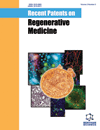- Home
- A-Z Publications
- Recent Patents on Regenerative Medicine
- Previous Issues
- Volume 5, Issue 2, 2015
Recent Patents on Regenerative Medicine - Volume 5, Issue 2, 2015
Volume 5, Issue 2, 2015
-
-
Clinical Grade Stem Cell Culture
More LessAuthors: Nandaraj Taye and Maria V. CamarasaUse of animal products to culture human stem cells poses risk of pathogens and other contaminations which may render stem cells therapeutically unsuitable. Hence, it is necessary to meet the standards of good manufacturing practices, clinical-grade like and xeno-free conditions. The protocol for culturing clinical grade stem cells needs to be modified so that maximum utilization can be done for stem cell therapies. Modification Read More
-
-
-
Directed Differentiation of Pluripotent Cells Towards Therapeutic Stem Cells
More LessRegenerative medicine seeks to restore normal architecture and function of tissues which have been damaged by disease, trauma and/or ageing. Stem cells are known to be an integral part of any regeneration process. Their isolation or generation, in vitro expansion, recruitment and transplantation to the damaged sites are being heavily pursued. Several applications of pluripotent cell derivatives have arrived at the cl Read More
-
-
-
Innovative Concepts of Cell Therapy: Pluripotent and Multipotent Stem Cells and New Bio-Material Solution in Research and Clinical Application
More LessAuthors: Ciro Gargiulo, Pham V. Hung and Melvin SchifmanMultipotent and pluripotent Stem cells are highly clonogenic populations of cells considered the utmost promise in the field of regenerative medicine. By definition stem cells are progenitor cells capable of self-renewal and differentiation hypothetically “ad infinitum” into more specialized cells and mature tissue. Stem cells are commonly classified based on the developmental stage from which they are isolated, although th Read More
-
-
-
Therapeutic Nucleic Acids
More LessAuthors: Víctor M. Gálvez, María V. Camarasa and Ana MuñozGene therapy strategies have become involved in methods for the treatment of inherited or acquired diseases with the aim to correct the faulty genetic code or to modify gene expression. In order to develop safe and effective therapeutic methods for applying in humans, different nucleic acids, termed as vectors, have been engineered, as therapeutic molecules in addition to classical drugs. In this review we included an ov Read More
-
-
-
Novel Methods of Genetic Modification of Human Pluripotent Stem Cells
More LessGenomic engineering has enormous potential along basic research, drug discovery and cell therapeutics. Many existing methods for targeted gene knockout mutagenesis or integration rely on homologous recombination. The low rate of spontaneous recombination in nearly all mammalian cell types, as well as the scale of screening, effort and time required to isolate the targeted events during genome modification, have hinder Read More
-
-
-
Stem Cell Therapies
More LessAuthors: Ana L. Muñoz, Víctor M. Galvez and María V. CamarasaStem cells have the ability to self-replicate in vitro indefinitely under adequate conditions and provided that pluripotent signals are triggered exogenously. Moreover, they are able to differentiate into virtually all human cell types. This vast potential makes stem cells a powerful tool to be used in regenerative medicine and different therapeutic strategies as well as in clinical and basic research, contributing to the generatio Read More
-
-
-
Patented Small Molecules Used for Reprogramming
More LessAuthors: Manasi A. Agrawal and Biswa P. ChatterjiStem cells possess a great potential of differentiating into various types of cells. They are capable of sustaining their stemness or getting converted into cells having a more specialized function in the body. The obstacles that pose as a barrier to the therapeutic and clinical applications of stem cells are the difficulty in deriving and controlling the fate of these stem cells. With the advancement of science and technology and with Read More
-
Volumes & issues
Most Read This Month
Article
content/journals/rpgm
Journal
10
5
false
en


